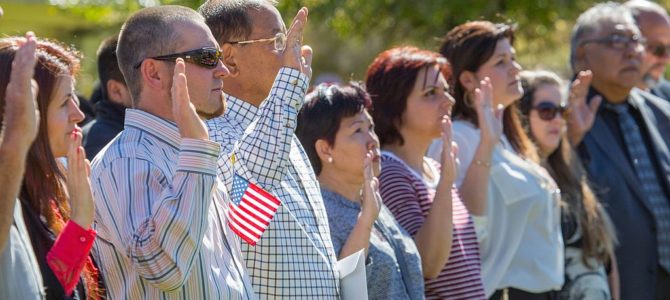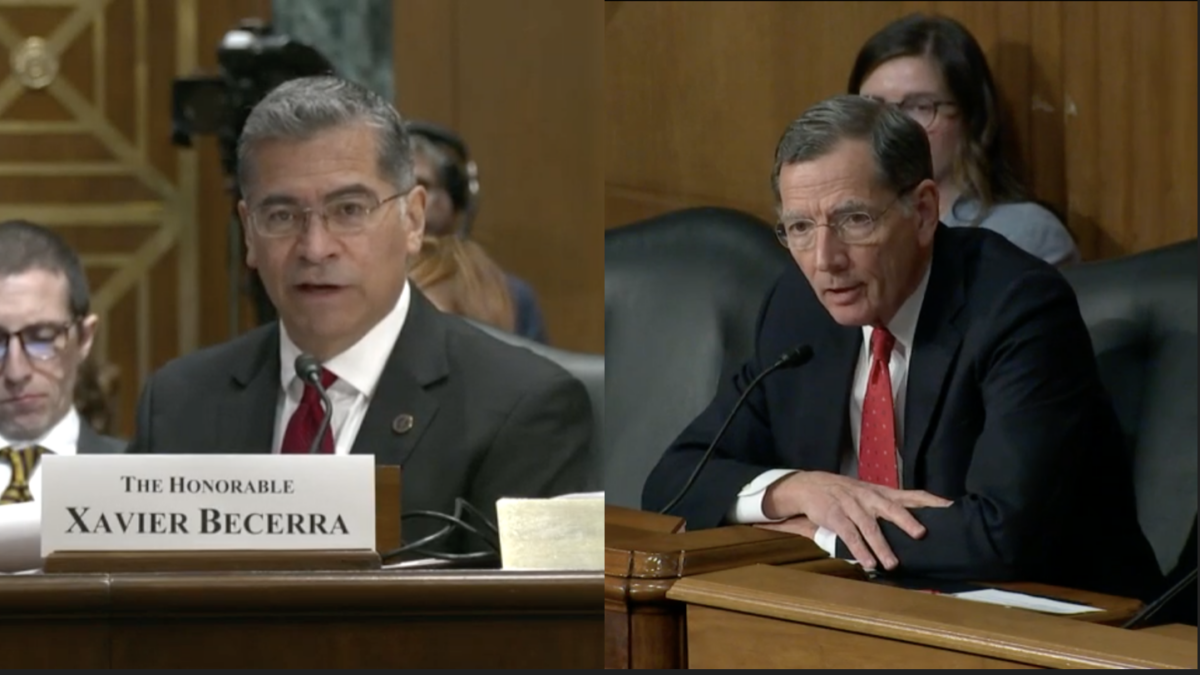
President Trump is very good at energizing his base while baiting his political opponents to go where he wants them to go. His tough stance on illegal immigration was one of the reasons he got elected. So he followed his winning formula by highlighting his resolve on “solving” the illegal immigration issue leading up to the midterm elections.
One week before the election, he mentioned in an interview that he was entertaining the idea of using an executive order to end birthright citizenship. Immediately, his remarks generated wall-to-wall coverage on birthright citizenship, heated debates from both the left and right on how to interpret the 14th Amendment, and whether the president has the legal authority to end birthright citizenship with an executive order.
During this heated debate, one name has been mentioned repeatedly: Wong Kim Ark, a Chinese American whom many say solidified birthright citizenship for future generations. The true history is, of course, more complicated than that simple narrative.
The Wave Of Chinese Immigrants
Through the mid- to late 19th century, American attitudes toward Chinese immigrants experienced several shifts. Chinese immigrants were initially welcomed during the Gold Rush because of their reputation for having good work ethics. However, when the gold mines began being exhausted, the welcome turned into hatred.
Chinese laborers were accused of stealing American jobs and driving down wages. By around 1869, they had become “the constant victims of cruel harshness and brutal violence,” according to Frederick Douglass. For instance, 200 Chinese miners were robbed and four were murdered at Rich Gulch, California, in 1852.
Yet when the Central Pacific Railroad couldn’t find sufficient willing Americans to take on the back-breaking and often dangerous work of building the transcontinental railroad, it turned to the group it knew it could depend on: Chinese immigrants. Goodwill toward the Chinese immigrants quickly faded after the transcontinental railroad was completed. Chinese immigrants were viewed not only as an inferior and undesirable population, but also as an actual threat to American culture, American government, and even the Caucasian race. They were offensively referred to as the “yellow peril” and often the target of violence.
It was during this hostile environment that Wong Kim Ark was born in 1873 in San Francisco. His parents were legally domiciled and residents of the United States at the time of his birth.
Discrimination Against Chinese Workers
That same year, a financial panic put many American workers out of work. Unemployed Americans became extremely hostile to immigrants, especially the Chinese. In 1877, the Workingman’s Union was established in San Francisco and Denis Kearney, a leading anti-Chinese union member, was elected secretary. The Workingman’s Union later formed the Workingman’s Party and became a powerful political force in California. The party supported legislators who drafted many discriminating bills against Chinese immigrants.
Since the U.S. economy during the second half of the 19th century was dominated by manufacturers and railroads, organized laborers from these industries were powerful political forces that many politicians were only too happy to appease. Therefore, Congress passed the Chinese Exclusion Act in 1882.
The act (its scope was later expanded) suspended the immigration of Chinese laborers, skilled or unskilled, for a period of 10 years. It also required every Chinese person traveling in or out of the country to carry a certificate identifying his or her status as a laborer, scholar, diplomat, or merchant. The 1882 Act was the first and only immigration law in the U.S. history that prevented immigration and naturalization based on race and nationality.
Although initially only Chinese immigrants were targeted by it, the law was quickly extended to restrict immigration of other Asians, including Japanese, Asian Indian, Filipino, and Korean immigrants. There was no shortage of legal challenges to fight back the 1882 Act, including Chan Ping vs. U.S. (1889), where the Supreme Court upheld the constitutionality of the Chinese Exclusion Act, and Fong Yue Ting vs. U.S. (1892), in which the Supreme Court upheld the constitutionality of requiring all Chinese to register for certificate of residency or be subject to deportation.
The most famous case is the United States v. Wong Kim Ark . According to court documents, Wong’s parents lived in San Francisco until 1890, when they returned to China and brought Wong with them. Wong came back to the United States in the same year and “was permitted by the collector of customs to enter the United States upon the sole ground that he was a native-born citizen of the United States.”
In 1894, he left to visit China again and returned in August 1895. He was then denied reentry on the ground that he wasn’t a U.S. citizen according to the Chinese Exclusion Act of 1882. Wong challenged the government, arguing he was a natural-born U.S. citizen per the first clause of the 14th Amendment, which declares that “all persons born or naturalized in the United States, and subject to the jurisdiction thereof, are citizens of the United States.”
Protecting Wong Kim Ark’s American Citizenship
The Supreme Court ruled in Wong’s favor partially based on their interpretation of the key phrase “subject to the jurisdiction thereof,” which they believed referred to being required to obey U.S. law, but the majority mainly based their opinion on the British common law’s definition of citizenship, which states that anyone who “is born within the British dominions is a natural-born British subject.”
By that definition, the majority of the court agreed everyone who is born in the United States, with a few exceptions (i.e. diplomats or someone who is hostile to the United States), is a natural-born U.S. citizen. That’s how birthright citizenship was established. Interestingly, after winning his hard-earned U.S. citizenship, Wong eventually settled in China and never came back.
But the ruling established by United States v. Wong Kim Ark enabled children of Chinese immigrants and other Asian immigrants’ children who were born in the United States to bypass the restrictions set by the 1882 Chinese Exclusion Act and obtain U.S. citizenship. After the 1906 San Francisco earthquake destroyed many public records, including birth certificates, many Chinese immigrants claimed they were born in San Francisco and thus were natural-born U.S. citizens. With their newfound citizenship, they were able to sponsor other young Chinese to immigrate to the United States as their paper sons and daughters. Many reported that they took such desperate measures as a response to the Chinese Exclusion Act.
The 1882 act was eventually repealed by the 1943 Magnuson Act. On January 18, 1944, Edward Bing Kan, the son of a Chinese vegetable peddler and an interpreter who worked for the Immigration and Naturalization Service’s (INS) Chicago office for 35 years, became the first Chinese American to take the oath and become a naturalized U.S. citizen after the repeal of the Chinese Exclusion Act.
It’s fair to say that if not for the bigotry of the Chinese Exclusion Act, there wouldn’t be United States v. Wong Kim Ark. The 14th amendment probably would have been interpreted very differently and today we probably would be having a different kind of discussion regarding citizenship.
Repealing Quotas And Expanding Birthright Citizenship
The repeal of the Chinese Exclusion Act was a welcome sign, but it did very little to open doors for would-be Chinese immigrants to America, because the Magnuson Act established an annual quota of 100 immigration visas for each Asia nations including China. This highly restrictive quota was eventually repealed in 1952.
Of course, Chinese immigrants’ children are not the only ones who have benefited from birthright citizenship. Millions of children of immigrants of all skin colors and countries of origin have obtained U.S. citizenship through birth. Many are patriots and have made valuable contributions to America.
Americans hadn’t considered birthright citizenship a problem until three things took place: First, the 1952 Immigration Act for the first time established family reunion as the main channel for legal immigration, allowing a U.S. citizen and, in some instances, permanent residents to sponsor spouses, parents, children and siblings. All immigration laws enacted since 1952 have kept this policy, which has opened the door for “chain” migration and has made a U.S. citizenship particularly valuable to illegal immigrants.
Second, a study by the Center for Immigration Studies (CIS) shows welfare usage by immigrant households was higher than households headed by native-born Americans because “immigrants often receive benefits on behalf of their US-born children.” Results like these prompt resentment and have been widely cited by anti-immigration groups and politicians as evidence that immigrants use birthright citizenship to take advantage of our nation’s generous welfare system, even though a Cato Institute study shows that poor immigrants use public benefits at lower rates than native-born citizens on an individual basis.
Third, as the worldwide standard of living is improving, more people can afford so-called birth tourism, in which foreign pregnant women travel to the United States with the sole purpose of giving birth here so their children will have U.S. citizenship. An estimated 40,000 children are born in the United Sates annually to foreign women who came on tourist visas. Guess which country has sent the United States the most birth tourists? China, Wong Kim Ark’s home land. Early this year, the government raided several “maternity hotels” in California that particularly cater to pregnant mainland Chinese women.
President Trump’s interview comments have renewed the debate on birthright citizenship. To have a spirited national conversation, we need to understand the historical context and honestly examine birthright citizenship’s benefits, flaws, and abuses.








